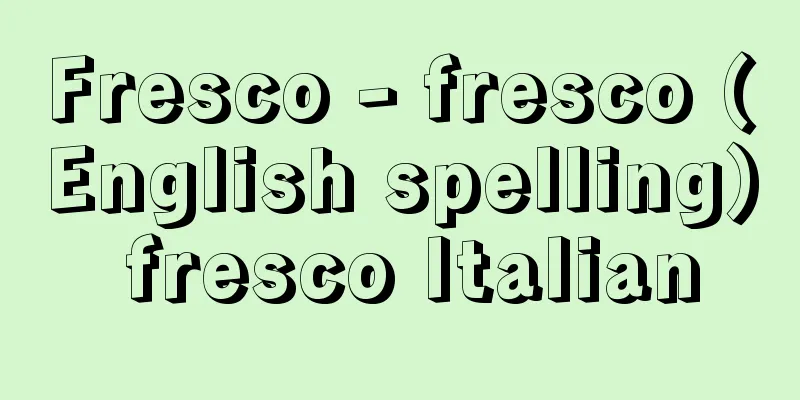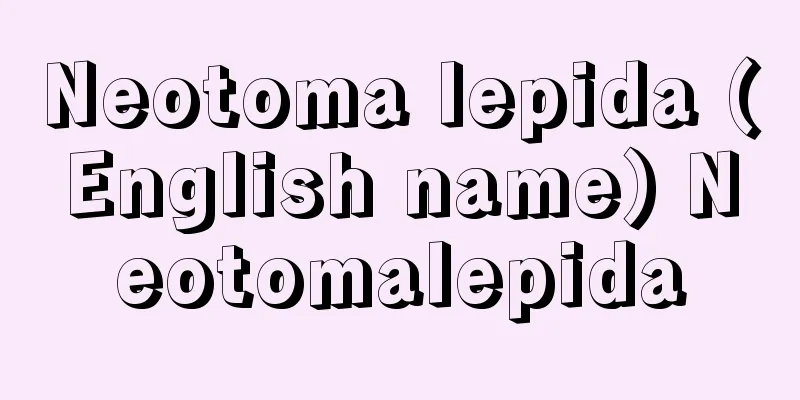Fresco - fresco (English spelling) fresco Italian

|
A mural technique that was popular in Italy from the end of the 13th century to the mid-16th century. Fresco is the English word for "fresh," and is named after the technique of painting on fresh (still wet) lime plaster walls. Therefore, the word fresco should not be used for murals in general, and the "true fresco" (buon fresco) technique should be clearly distinguished from the secco technique, which is painting on dry walls (secco), as well as the mezzo fresco technique, which is painting on walls that are somewhat dry. In true fresco, the pigments are dissolved in water (or sometimes lime water) alone, and no adhesive or binder medium is used like in regular paints. The pigments in fresco become integrated with the wall surface as the lime plaster dries and hardens due to a chemical reaction. The pigments applied on wet lime plaster penetrate the plaster wall and form a paint layer. In other words, when lime plaster (calcium hydroxide and water) combines with carbon dioxide in the air, it releases water and changes into limestone (calcium carbonate), creating a strong, water-insoluble paint layer that becomes one with the wall. [Hasegawa Saburo] Creation of the fresco(1) Arriccio: Applying lime plaster mixed with sand to a stone wall. (2) Sinopia: A composition is drawn with charcoal, then thinly diluted with ochre (a natural yellow pigment) and painted over, followed by a sketch with a red earth pigment called sinopia. This sinopia technique was often used from the mid-13th century to the mid-14th century and from the late 16th century to the early 17th century. (3) Intonaco: The top layer of paint for painting. It is made of lime plaster mixed with fine sand or marble powder. This paint is applied just before painting, and only to certain areas (called giornata) that the painter can finish in a day. (4) If a sinopia is not drawn, the composition is transferred after the intonaco. There are two ways to do this: [a] spolvero: A method in which small dotted holes are made along the outline of a paper (carton) on which a full-sized sketch of the composition has been made, the paper is placed over an intonaco, and a cloth bag filled with powdered charcoal is struck from above to transfer the image. This was the most commonly used transfer method from the mid- to late 15th century. [b] A method in which the carton is placed over the paper, the outline is traced with an iron stylus, and the indented lines are engraved onto the intonaco to transfer the image. This method was used frequently in the 16th century. (5) Painting is done using pigments dissolved in water (or lime water). The pigments must be natural, alkali-resistant earth pigments. The artist must complete the giornata accurately and within the time limit, based on his or her own ability and the level of difficulty of the details. No alterations or additions are permitted, and if the artist makes a mistake in the touch, the work must be started over from the intonaco stage. As Vasari said, the fresco technique is a "masculine" and "solid" painting technique, suitable only for great painters with outstanding skills. It also produces beautiful, completely matte colors with bright, transparent colors, and acquires a deep, elegant shine with age, making it the best mural technique for creating truly monumental paintings. The splendor and vivid beauty of the colors of Giotto's Arena Chapel (Padua), Piero della Francesca's murals in the Basilica of San Francesco (Arezzo), and Michelangelo's Sistine Chapel (Vatican), all of which represent the 14th, 15th, and 16th centuries, fully demonstrate the characteristics of the fresco technique. The fresco technique, which was praised as the "most beautiful and most delicate" (Cennino Cennini) and the "most enduring" (Vasari), also declined along with Renaissance painting. The reasons for this include: (1) when a painter paints on a wet wall, he cannot see the color when it dries, (2) he is not allowed to make corrections or additions, and (3) he has to paint step by step according to the giornata, which means that he is tied up for a long time on one work. In other words, because it was a difficult technique that required skill, and was also economically disadvantageous, painters stopped paying attention to the fresco technique as times changed. [Hasegawa Saburo] Source: Shogakukan Encyclopedia Nipponica About Encyclopedia Nipponica Information | Legend |
|
13世紀末から16世紀中葉にかけて、イタリアで盛んに行われた壁画技法。フレスコは英語の「フレッシュ」に相当し、新鮮な(まだぬれている)石灰漆喰(しっくい)の壁に描く技法からの名称。したがってフレスコの語を壁画一般に用いることは避けるべきで、「真のフレスコ」(ブオン・フレスコbuonfresco)技法は、乾いた壁(セッコsecco)に描くセッコ技法はもちろん、ある程度乾いた壁に描くメッツォ(メゾ)・フレスコmezzo fresco技法とも画然と区別すべきである。真のフレスコ技法では、原則として顔料は水(ときには石灰水)だけで溶かれ、通常の絵の具のような接着剤やつなぎ材としてのメディウムは使用しない。フレスコ画の顔料は、石灰漆喰の化学変化による乾燥硬化で壁面と一体化する。ぬれた石灰漆喰の上に塗られた顔料は漆喰壁に浸透して絵の具層を形成する。つまり、石灰漆喰(水酸化カルシウムと水)は空気中の炭酸ガスと化合する際、水分を放出して石灰岩(炭酸カルシウム)の状態に変化し、壁と一体化した非水溶性の強靭(きょうじん)な絵の具層をつくるのである。 [長谷川三郎] フレスコ画の制作(1)アリッチオarriccio 石壁の上に砂を混ぜた石灰漆喰を塗る。 (2)シノピアsinopia 木炭で構図を描き、オーカー(天然黄色顔料)を薄く溶いて塗り重ねたのち、シノピアとよばれる赤色土性顔料で素描する。このシノピア技法は13世紀中葉から14世紀中葉、および16世紀末から17世紀初めによく行われた。 (3)イントーナコintonaco 絵を描くための最上層の地塗り。目の細かい砂や大理石粉を混ぜた石灰漆喰を塗る。この地塗りは、1日で画家が描き終えられる一定の部分(ジョルナータgiornataという)だけに、絵を描く直前に塗られる。 (4)シノピアが描かれない場合には、イントーナコのあとで構図を転写する。これには次の二つがある。〔a〕スポルベロspolvero 原寸大の構図を素描した紙(カルトン)の輪郭線に点線状に小孔をあけ、イントーナコに当て、上から木炭粉末の入った布袋をたたき付けて転写する方法。15世紀中葉から後半にかけてもっともよく使われた転写法。〔b〕カルトンを当てて鉄筆で輪郭線をトレースし、イントーナコ上にへこんだ線を刻み付けるようにして転写する方法。16世紀に多用された。 (5)水(または石灰水)で溶いた顔料を用いて絵を描く。顔料は耐アルカリ性の天然土性顔料を選ぶ。画家は自分の力量や細部の難易度に応じて決定したジョルナータを、的確に時間内に完成することが条件となる。改変や加筆は許されず、タッチを誤るとイントーナコの段階からやり直さなければならない。 フレスコ技法は、バザーリのことばにあるように、卓越した技量を備えた大画家にこそふさわしい「男性的」で「確固たる」絵画技法である。また色彩は明るく透明感にあふれて完全にマットな美しい画面をつくり、経年変化によって格調高い深い輝きを帯びるなど、真にモニュメンタルな絵画の制作に適した最高の壁画技法である。ジョットのアレーナ礼拝堂(パドバ)の壁画、ピエロ・デッラ・フランチェスカのサン・フランチェスコ聖堂(アレッツォ)の壁画、そしてミケランジェロのシスティナ礼拝堂(バチカン)の天井画、14、15、16世紀を代表するこれらのフレスコ画連作の壮麗さと色彩の鮮明な美しさは、フレスコ技法の特質を十分に物語っている。「もっとも美しくもっとも精緻(せいち)な」(チェンニーノ・チェンニーニ)、そして「もっとも永続的な」(バザーリ)技法とたたえられたフレスコ技法も、ルネサンス絵画とともに衰退した。その理由として、〔1〕画家がぬれた壁に色を塗る際、乾いたときの色調を見ることができない、〔2〕修正加筆が許されない、〔3〕ジョルナータに従って手順を踏んで描き進めねばならず、一つの仕事に画家は長期間拘束される、などがあげられる。すなわち、熟練を要する困難な技法であったこと、加えて経済的にも不利だったため、時代の変化とともに、画家たちはフレスコ技法を顧みなくなったのである。 [長谷川三郎] 出典 小学館 日本大百科全書(ニッポニカ)日本大百科全書(ニッポニカ)について 情報 | 凡例 |
Recommend
Scirpus mitsukurianus (English spelling) Scirpus mitsukurianus
…[Tetsuo Koyama]. … *Some of the terminology that...
lip sync
...Time delay devices are used not only to create...
Kaga Silk
〘Noun〙 (also "kagakinu") Silk fabric pro...
Government agency - Kancho
〘 noun 〙① An office of the Daijokan under the Rits...
Erasistratos - Erasistratos (English spelling)
An ancient Greek physician. Born in Iulia on the ...
Oranges - Dry
…The members of the winter flock are fixed, and e...
Bishop - English
It is a term used in Christian Eastern Orthodox C...
Yettatura - Yettatura
...This miracle of blood thawing is considered a ...
Large shield - Otate
〘Noun〙 A large shield. ※The Chronicles (720), Nove...
Mr. Suyama
A medieval local lord from Suyama Village, Oda Cou...
Chososhi Kinoshita - Chososhi Kinoshita
Year of death: 15th June 1649 (24th July 1649) Yea...
bourtree
…Japanese elderberry is also called sekkotsu-ki a...
Winterthur (English spelling)
A city in the northeastern part of Switzerland, in...
Kawamata Mikuriya
…According to the deed of succession in 1252 (Ken...
Jurisdiction - Saibankankatsu
It refers to the provisions regarding how jurisdi...








![Inazumi [Hot Spring] - Inazumi](/upload/images/67caefb293578.webp)
![Momoyama [town] - Momoyama](/upload/images/67cd0644a41e2.webp)